NVIDIA Tegra Note 7 Review
by Brian Klug on November 12, 2013 9:01 AM EST- Posted in
- Tablets
- Mobile
- Tegra 4
- NVIDIA
- Tegra Note
NVIDIA is launching Tegra Note running “100% stock” Android 4.2.2. The UI is essentially stock, although there are obviously additional items inside the settings menu which are Tegra Note specific, and of course the changes to accommodate Tegra Note’s built in stylus.
Like Shield, NVIDIA is responsible for timely OTA updates to Tegra Note, and although the tablet is launching running 4.2.2, you’ll basically get updates in step with the Tegra 4 BSP. There’s a few things missing from this version of the software we’re looking at right now that will make it into the final image in the December timeframe with Android 4.3, including always on HDR for the camera, and hopefully moving apps to SD card.
The customizations that NVIDIA has made to the Android platform primarily focus around compatibility with the custom stylus solution that lends Tegra Note its namesake. NVIDIA has coined it DirectStylus, and really it’s an evolution of DirectTouch, which offloads the touch controller processing after analog to digital conversion onto the shadow core onboard Tegra 4.
NVIDIA claims DirectStylus offers much the same feature set as an active digitizer at a fraction of the implementation cost. Instead of using an additional layer in the touch panel and a special stylus, this works with a normal capacitive stylus and digitizer. NVIDIA is being tight lipped about just how they’re sampling the display to enable detection of the two different stylus tips, but it does work.
The implementation supports almost everything you’d expect from an active stylus, including palm rejection, pressure sensitivity, orientation sensitive tips (like the chisel tip), and very fine control. The only obvious omission is hover support, which active systems still seem to have a leg up with. The real differentiator for the Tegra Note however is that it delivers almost all of the experience critical for note taking, drawing, or annotating documents at a fraction of the cost. I played around with DirectStylus inking on the Tegra Note and didn’t notice any problems, if you didn’t know better you could easily mistake the experience for one afforded by a much more expensive active solution, and at the same time this solution seems to have lower latency. NVIDIA claims 3x lower latency versus a Galaxy Note 8, and although I haven’t used one directly, inking lags behind my pen tip considerably less than I remember it lagging with the Galaxy Note 10.1 (2013) or Note 3, although those aren’t direct competitors. Palm rejection works well on the Tegra Note 7 as well, something I expected would be problematic given the shared capacitive sensing.
Tegra Note comes with a chisel tip stylus, although there’s also a fine point tip available. The stylus feels surprisingly nicely weighted, solid, and comfortable to use. I had limited success using the Tegra Note with the only other capacitive stylus I have available from the HTC One max, but NVIDIA claims it will indeed work with other popular capacitive styli.
The Tegra Note comes preloaded with two inking related applications out of the box, Tegra Draw, and Write. The first is self explanatory, it’s a simple drawing app with a color picker, a variety of available software tip types, and the ability to save to a final image. The Write application is a more fleshed out note taking app with basic organization support. What’s missing is the kind of comprehensive writing to text conversion that other devices which include inking support have, or the third party keyboard that takes advantage of inking.
When the stylus is withdrawn from its holder, at the bottom are two additional buttons. One allows you to lock out other capacitive inputs and put the Tegra Note in a pen-only mode, the other is a lasso like snipping and annotation mode which lets you grab anything on screen.
Although others have more fleshed out software support, NVIDIA has nailed what I’d consider the baseline set of features necessary for a product which emphasizes its note abilities. If taking notes or drawing is a priority, the Tegra Note’s value prospect is immediately obvious compared to some of the more expensive devices with active digitizers.
It’s also worth noting that Tegra Note includes support for console mode and the same level of bluetooth third party controller support that Shield brought. What’s absent however is GameStream compatibility, since Tegra Note lacks 5 GHz WiFi.


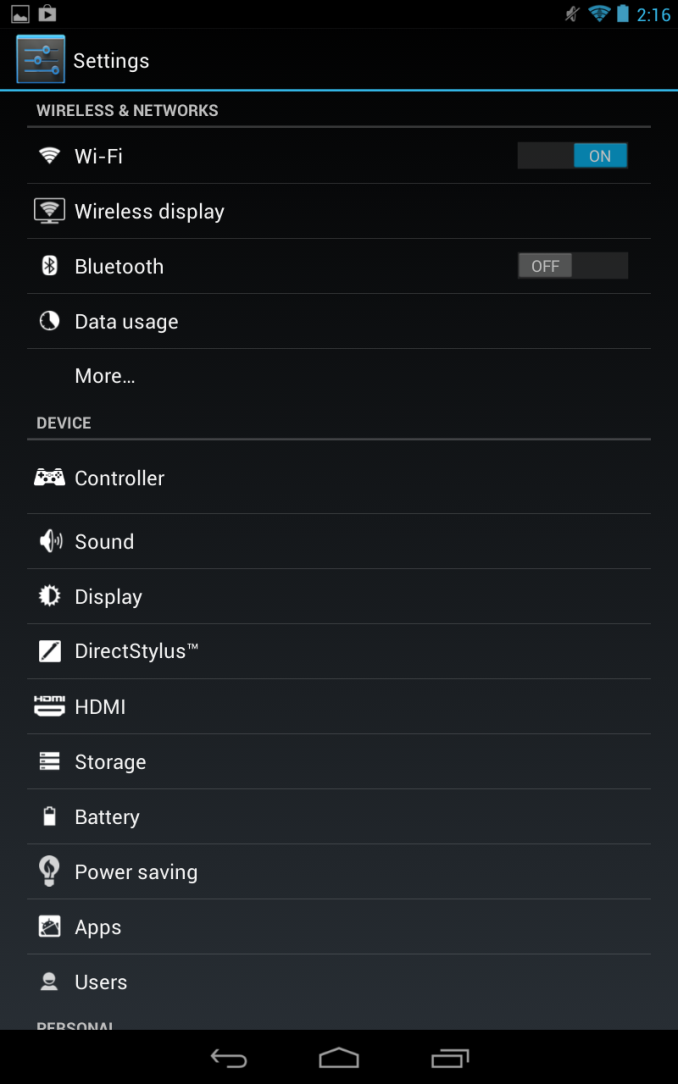
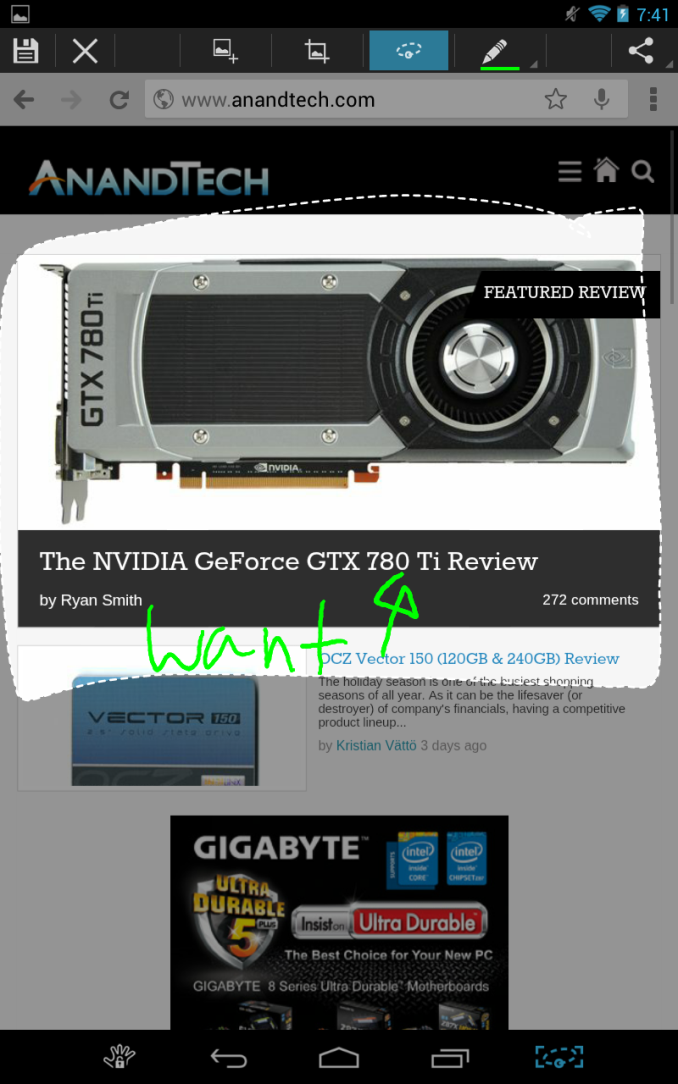


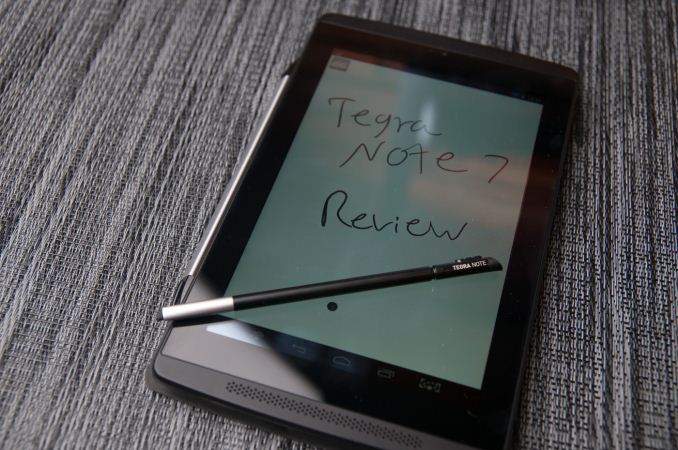
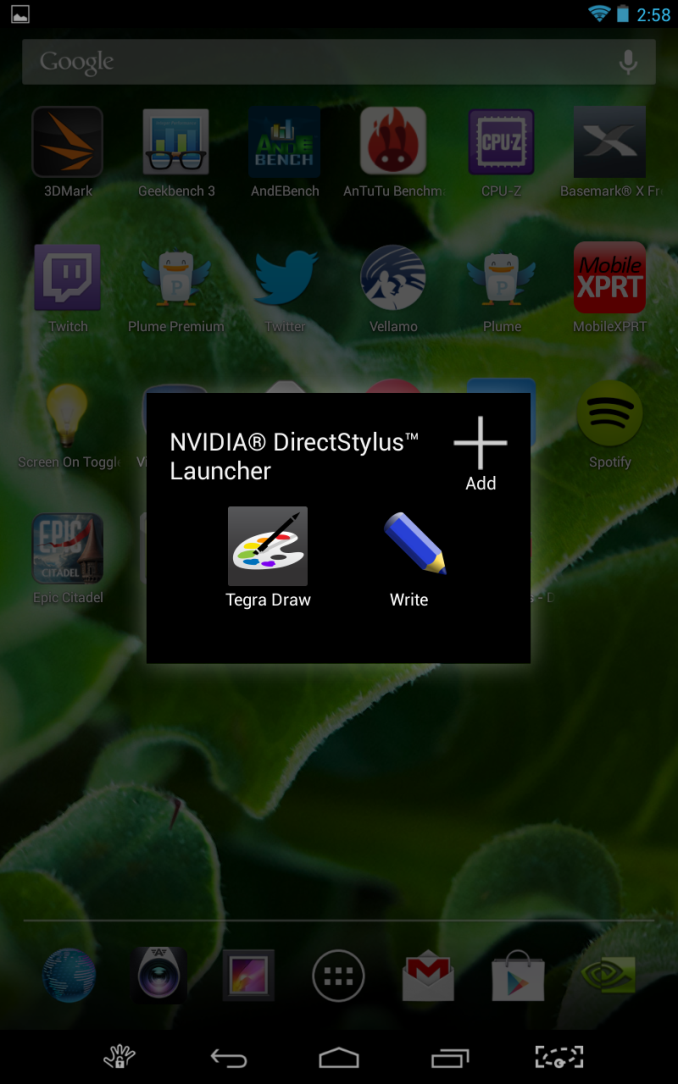
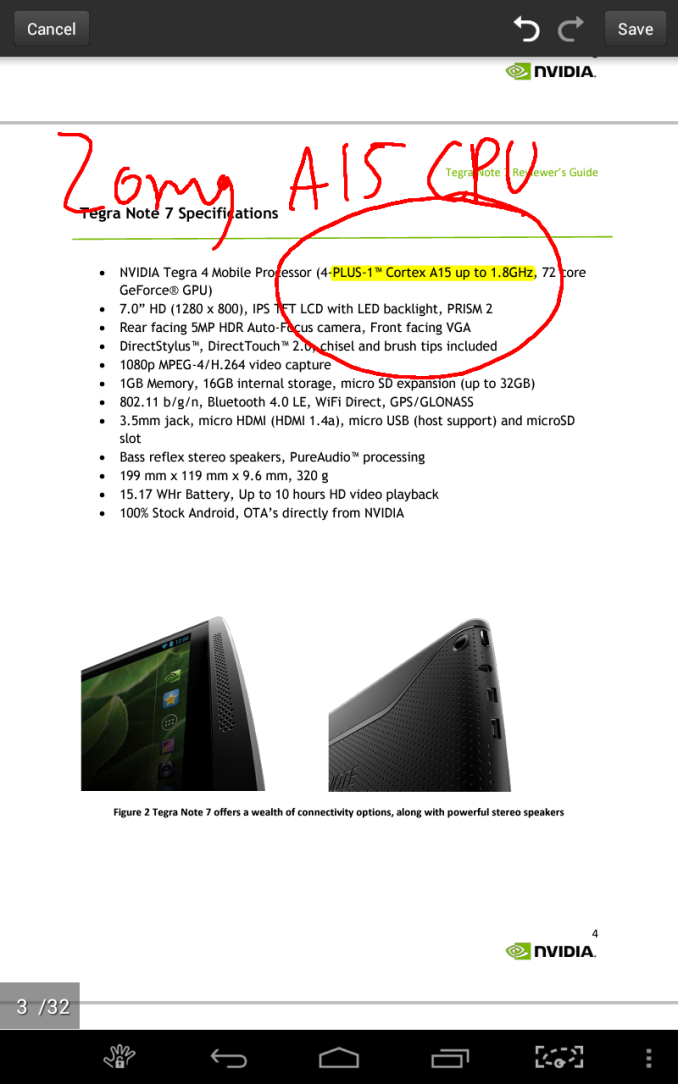

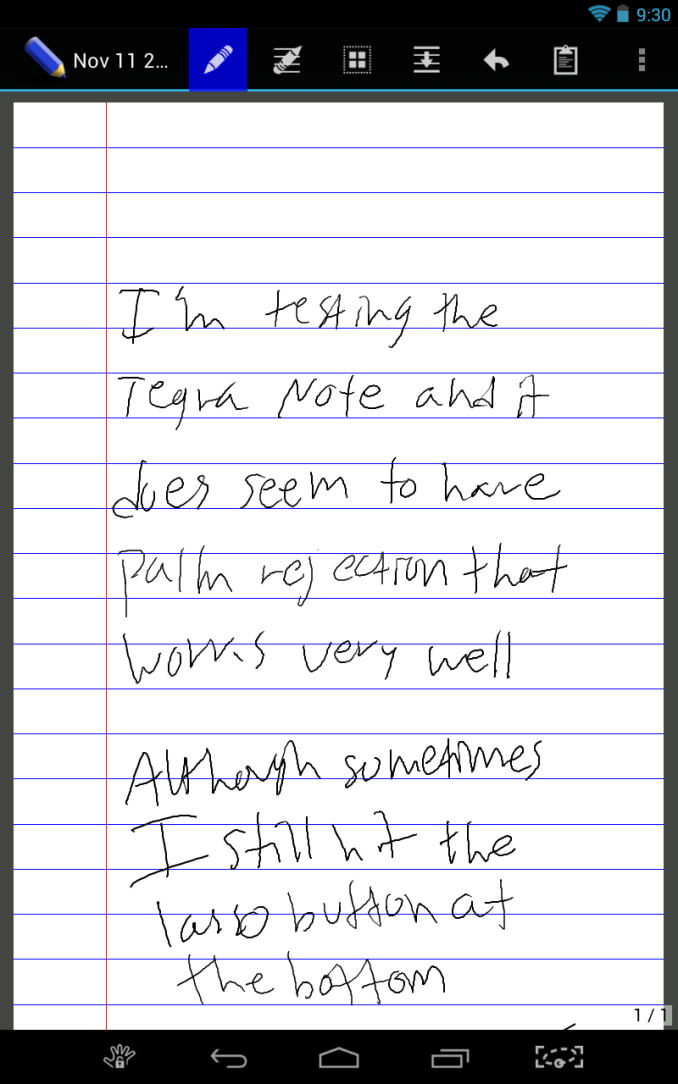








87 Comments
View All Comments
bleh0 - Tuesday, November 12, 2013 - link
No reason to get the Nexus 7 anymore. Outside of the display and a few other things the Tegra Note seems to be the superior device.Pirks - Tuesday, November 12, 2013 - link
yeah, and especially for gaming it's absolutely top notch, just like iPad, but more than twice cheaper, I'll preorder a couple more Tegra Notes today for my buddies in commie-infested Canada LOLDa W - Tuesday, November 12, 2013 - link
Commie-infested Canada? What Canada you talkin' bout? Sure ain't good ol western Canada, we shot all those damn commies a while ago!Pirks - Tuesday, November 12, 2013 - link
I'm talking about high taxes and "free" waitlist laden healthcare, smells like a commie to me :Pquickbunnie - Tuesday, November 12, 2013 - link
One of the pictures says tegra note 3 instead of 7.Also, shouldn't the white point average be a deviance from 6504 and ordered from smallest to largest? Currently the worst offenders are on top, inconsistent with all the other display graphs.
Hrel - Tuesday, November 12, 2013 - link
Not even past the first page, Asus Nexus 7 wins. Resolution, by far. It doesn't even cost more, it costs less... wtf?UpSpin - Wednesday, November 13, 2013 - link
Out of the resolution (and with it the required more RAM) I don't see any other advantages the Nexus 7 offers.The Tegra Note 7 is, prorably, more intended for young people, maybe those who study, with a small focus on gaming:
- Much faster SoC
- Pressure sensitive note taking to properly annotate PDF documents or take notes (awkward on the Nexus 7), the only other option to take proper notes is the the much more expensive Galaxy Tablet with a WACOM digitizer.
- better sound, due to stereo front facing speakers
- SD-Card support, which, in my opinion, for a tablet, is major advantage to load larger movies etc. on the tablet.
- $30 less expensive
So considering the price and the features, I think it's a great tablet, and depending on the usage, offers more than the Nexus 7.
Still, I hope they also release a Tegra 10 Note, for maybe $300, with a HD Display and note taking capability, the would be awesome and a Galaxy Tab Note killer.
Yojimbo - Friday, November 15, 2013 - link
<quote> The Tegra Note 7 is, prorably, more intended for young people, maybe those who study, with a small focus on gaming </quote>True, except for one thing. A 7 inch tablet seems small for full-time note-taking. 7 inches is a good size for using at various times throughout the day, but if I were a full-time student using it hours each day and expected to do so for years, I would definitely demand something at least 10 inches, preferrably larger, say 12 or 13.
Hrel - Tuesday, November 12, 2013 - link
Nvidia is doing something kinda weird lately. They're taking chances, very safely. It'll be very interesting when all these products reach a stage of maturity. 2015/2016 maybe?andrewaggb - Tuesday, November 12, 2013 - link
I agree. They are interesting to watch at the moment. Losing out on all 3 console deals and the vast majority of the tablet/phone market leaves you with a hole to fill. I hope they pull through.They're in a similar situation to AMD, but seemingly doing more about it.